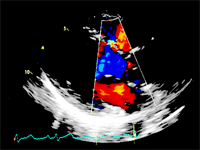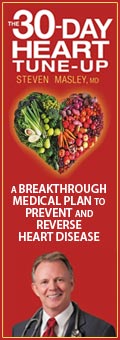Echocardiography
Echocardiography or heart ultrasound is a noninvasive, painless method, does not require special preparation, have no adverse effects and can be applied at an early age, and if necessary, examination can be repeated without any risk of damage to the tissue.
Echocardiography is a technique that quickly creates a pulsing sound wave with ultrahigh frequency.
When these waves encounter an object of different density, some waves bounce back as echoes and there are displayed on an oscilloscope or a moving paper, defining the different structures of the heart.
This type of medical exam gives us important information about the morphology and function of the heart muscle, heart valves, cardiac cavity size, the speed of blood flow through the heart and major blood vessels. Doppler technique enables visualization of blood flow and velocity through the heart chambers and blood vessels.
Echocardiography with help from 2D, 3D images and Doppler, manages to display the heartbeats. Echocardiography sometimes uses a small amount of saline that medical personnel inject into the veins in order to eliminate the disturbance of the rib cage. Echocardiography is a test in which there is no special preparation, except that you should not drink and eat a couple of hours before the echocardiography. During echocardiography medical personnel may ask you to change position or to hold your breath for a short period of time. The pressure of a sonographer can be a little higher, but it is in order to obtain a better picture of your heart.
Echocardiography has exceptional significance in the detection and evaluation, as well as on the effects of different treatment of heart disease.
Echocardiography is used for:
- Diseases of the heart valves.
- Cardiomyopathy.
- Heart failure.
- Congenital and acquired heart defects.
- Myocardial infarction.
- Diseases of heart tissue (pericardium).
- Inflammation and other diseases of heart muscle (myocarditis).
- Evaluation of cardiac abnormalities in high blood pressure.
- The assessment of the large blood vessels in the heart (atherosclerosis, aneurysm).
- Heart rhythm disorders.
- Detection of thrombotic and tumor mass in the heart.
Completely painless pressure of transducer on the chest is obtaining a picture of the heart on the ultrasound screen. Echocardiography estimated size, appearance and mobility of the heart cavities, each individual heart wall, the look and function of the heart valves and major blood vessels of the heart.
Echocardiography allows the detection of the presence of any foreign mass in the interior of the heart and cardiac tissues. Thanks to the Doppler effect and obtain information about the direction, speed and the characteristics of the blood flow in the heart and we can calculate the pressures in the heart chambers and the lungs. Echocardiography is now and one of the most important diagnostic method that can be used as a first line for detection of heart disease, because it gives a lot of information and it is a painless, harmless and fast method.
The number and quality of information obtained by echocardiography is outclassing the other diagnostic methods and almost any cardiac examination cannot be done without him. It is recommended for cardiac patients and special population groups (athletes and people with occupations of public importance, pilots, bus drivers, a locomotive engineer.)
Echocardiography in sport
Sudden cardiac death of young people who participate in sports is one of the most tragic events. It is also an important social and medical problem with wide media coverage because it is an apparently healthy population. Sudden cardiac death occurs during or immediately after a high intensity physical activity. American College of Cardiology is considered echocardiography to be the main objective examination method for athletes, before starting physical activity, detection of silent cardiovascular disorders that can lead to sudden cardiac death. Discovering existing heart disease in athletes with echocardiography often leads to a complete cessation of sports in order to reduce the risk of sudden death. On the other hand, misdiagnosis of heart disease may also lead to the removal of athletes from sports activities, depriving him of the many benefits that sport brings.
Heart ultrasound or echocardiography is noninvasive and easily repeatable methods in sports cardiology, widely used to distinguish between changes of the heart caused by adaptation to stress and pathological changes. A high level of physical activity can lead to a certain degree of morphological and functional changes, which are called “athletic heart,” which are observed in about 50% of trained athletes. These changes include increasing of the size of cardiac cavities, increasing of wall thickness of left and right ventricle and left atrial size, but with preserved systolic and diastolic function. The shape and size of the change depends on the type and intensity of sports, training and characteristically relieve after of termination of exercise.
Routine use of echocardiography on athletes does not led to a significant increase in the number of detected hypertrophic cardiomyopathies. In athletes without subjective complaints, without family history or significant cardiovascular disease, with normal physical examination and normal ECG records, echocardiography has limited additional diagnostic value. It was found that extensive use of heart ultrasound leads to an increase in false positive or false negative results. Echocardiography examination of the heart is recommended for elite athletes involved in intense sports activities that can facilitate or lead to the appearance of an existing heart diseases.
However, the repeated assessments and reviews of these athletes who have the absence of symptoms, with normal physical examination and ECG records, remains unclear.
Echocardiography in children and babies
Echocardiography is non-invasive, painless, does not require special preparation, no adverse effects and can be applied at an early age, and if necessary examination can be repeated without any risk of damage to the tissue.
- Congenital hearts defect.
- Heart rhythm disorders.
- Arterial and pulmonary hypertension.
- Diseases of the heart valves.
- Inflammation of the heart muscle and cardiac membranes.
- Cardiomyopathy.
- Thrombotic and tumor mass in the heart chambers.
- Coronary artery disease.
You may also like:
- Cardiac tamponade
Cardiac tamponade is a rare life-threatening complication in which there is accumulation of fluids, blood, clots, or gases in the pericardial space.
- Heart Attack – acute myocardial infarction
Acute myocardial infarction or heart attack is sudden severe pain in the front of a chest, which leads to hypotension and shock.
- Arteriosclerosis | Arteriosclerotic heart disease
Arteriosclerotic heart disease or coronary artery atherosclerosis is the most common underlying cause of cardiovascular events and death.



